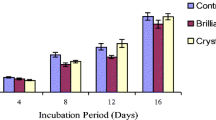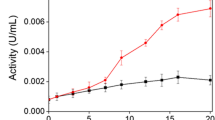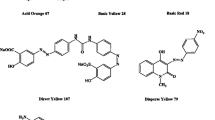Abstract
Phloroglucinol, thymol, and violuric acid (VIO) were selected as laccase mediators after screening 14 different compounds with indigo carmine (indigoid dye) as a substrate. With the presence of these three mediators, a nearly complete decolorization (90–100%) was attained in 1 h. Thus, these three compounds were used as mediators for the decolorization of other four dyes. The results indicated that VIO was effective mediator in decolorization of Remazol brilliant blue R (RBBR, anthraquinoid dye) and Coomassie brilliant blue G-250 (CBB, triphenylmethane dyes), and Acid red (diazo dye). In presence of VIO, the four dyes described above attained 70% decolorization. Thymol was able to mediate decolorization of RBBR and Azure A (heterocyclic dye). Phloroglucinol has no mediating capability in decolorization of the four dyes analyzed. Mediator concentration, pH, and copper ion have an effect on the decolorization of the RBBR. Our data suggested that the decolorization capabilities of laccase/mediator system were related to the types of mediator, the dye structure and decolorization condition.






Similar content being viewed by others
References
Abadulla E, Tzanov T, Costa S, Robra KH, Cavaco PA, Gubitz GM (2000) Decolorization and detoxification of textile dyes with a laccase from Trametes hirsute. Appl Environ Microbiol 66:3357–3362
Alcalde M, Bulter T, Arnold FH (2002) Colorimetric assays for biodegradation of polycyclic aromatic hydrocarbons by fungal laccases. J Biomol Screen 7:547–553
Baiocco P, Barreca AM, Fabbrin M, Galli C, Gentili P (2003) Promoting laccase activity towards non-phenolic substrates: a mechanistic investigation with some laccase-mediator systems. Org Biomol Chem 1:191–197
Camarero S, Ibarra D, Martinez MJ, Martinez AT (2005) Lignin-derived compounds as efficient laccase mediators for decolorization of different types of recalcitrant dyes. Appl Environ Microbiol 71:1775–1784
Campos R, Kandelbauer A, Robra KH, Cavaco PA, Gübitz GM (2001) Indigo degradation with purified laccases from Trametes hirsuta and Sclerotium rolfsii. J. Biochem 89:131–139
Claus H, Faber G, Konig H (2002) Redox-mediated decolorization of synthetic dyes by fungal laccases. Appl Microbiol Biotechnol 59:672–678
d’Acunzo F, Galli C (2003) First evidence of catalytic mediation by phenolic compounds in the laccase-induced oxidation of lignin models. Eur J Biochem 270:3634–3640
Fabbrini M, Galli C, Gentili P (2002) Radical or electron-transfer mechanism of oxidation with some laccase/mediator systems. J Mol Catal B Enzyme 18:169–171
Fu YZ, Viraraghavan T (2001) Fungal decolorization of dye wastewaters: a review. Bioresour Technol 79:251–262
Hadzhiyska H, Calafell M, Gibert JM, Dagà JM, Tzanov T (2006) Laccase-assisted dyeing of cotton. Biotechnol Lett 28:755–759
Johannes C, Majcherczyk A (2000) Natural mediators in the oxidation of polycyclic aromatic hydrocarbons by laccase mediator systems. Appl Environ Microbiol 66:524–528
Kandelbauer A, Erlacher A, Cavaco-Paulo A, Guebitz G (2004) Laccase-catalysed decolorized of the synthetic azo dye Diamond Black PV 200 and of some structurally related derivatives. Biocatal Biotransform 22:331–339
Kang KH, Dec J, Park H, Bollag JM (2002) Transformation of the fungicide cyprodinil by a laccase of Trametes villosa in the presence of phenolic mediators and humic acid. Water Res 36:4907–4915
Hong YZ, Zhou HM, Tu XM, Li JF, Xiao FZ (2007) Cloning of a laccase gene from a novel basidiomycete Trametes sp. 420 and its heterologous expression in Pichia pastoris. Curr Microbiol 54:260–2655
Liu W, Chao Y, Liu S, Bao H, Qian S (2003) Molecular cloning and characterization of a laccase gene from the basidiomycete Fome lignosus and expression in Pichia pastoris. Appl Microbiol Biotechnol 63:174–181
Liu WX, Chao YP, Yang XQ, Bao HB, Qian SJ (2004) Biodecolorization of azo, anthraquinonic and triphenylmethane dyes by white-rot fungi and a laccase-secreting engineered strain. J Ind Microbiol Biotechnol 31:127–132
Malhotra K, Sharma P, Capalash N (2004) Copper and dyes enhance laccase production in gamma-proteobacterium JB. Biotechnol Lett 26:1047–1050
Mechichi T, Mhiri N, Sayadi S (2006) Remazol Brilliant Blue R decolourization by the laccase from Trametes trogii. Chemosphere 64:998–1005
Minussi RC, Pastore GM (2007) Laccase induction in fungi and laccase/N-OH mediator systems applied in paper mill effluent. Bioresour Technol 98:158–164
Minussi RC, Pastore GM, Durán N (2005) Laccase induction in fungi and laccase/N–OH mediator systems applied in paper mill effluent. Bioresour Technol 98:158–164
Nilsson R, Nordlinder R, Wass U (1993) Asthma, rhinitis and dermatitis in workers exposed to reactive dyes. Br J Ind Med 50:65–70
Riva S (2006) Laccases: blue enzymes for green chemistry. Trends Biotechnol 24:219–226
Rodriguez CS, Sanromán M, Gübitz GM (2005) Influence of redox mediators and metal ions on synthetic acid dye decolourization by crude laccase from Trametes hirsute. Chemosphere 58:417–422
Spadarry JT, Isebelle L, Renganathan V (1994) Hydroxyl radical mediated degradation of azo dyes: evidence for benzene generation. Environ Sci Technol 28:1389–1393
Trupkin S, Levin L, Forchiassin F, Viale A (2003) Optimization of a culture medium for ligninolytic enzyme production and synthetic dye decolorization using response surface methodology. J Ind Microbiol Biotechnol 30:682–690
Vaidya AA, Datye KV (1982) Environmental pollution during chemical processing of synthetic fibers. Colourage 14:3–10
Acknowledgments
This project was funded by the National Key Basic Research Program of China (2003CB716005).
Author information
Authors and Affiliations
Corresponding author
Rights and permissions
About this article
Cite this article
Hu, M.R., Chao, Y.P., Zhang, G.Q. et al. Laccase-mediator system in the decolorization of different types of recalcitrant dyes. J Ind Microbiol Biotechnol 36, 45–51 (2009). https://doi.org/10.1007/s10295-008-0471-1
Received:
Accepted:
Published:
Issue Date:
DOI: https://doi.org/10.1007/s10295-008-0471-1




